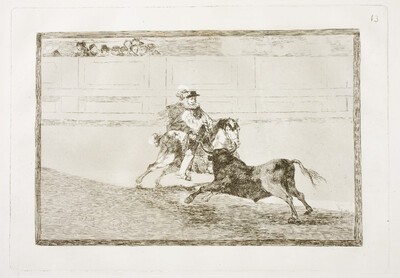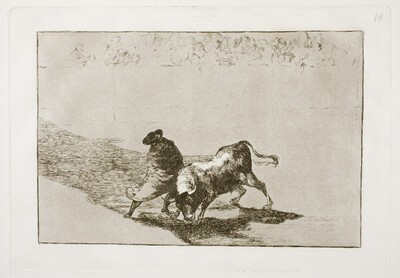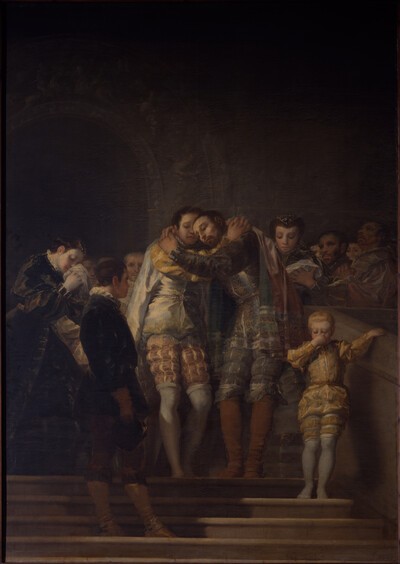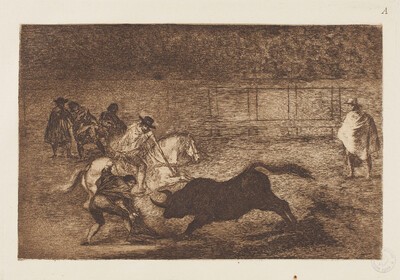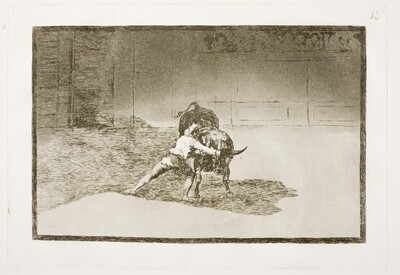- Cronología
- 1814 - 1816
- Dimensiones
- 247 x 353 mm
- Técnica y soporte
- Aguafuerte, aguatinta, punta seca, buril y bruñidor
- Reconocimiento de la autoría de Goya
- Documented work
- Ficha: realización/revisión
- 01 Oct 2021 / 22 Jun 2023
- Inventario
- -
13 (print, upper right-hand corner)
See How the ancient Spaniards hunted bulls on horseback in the countryside
A proof of the state before applying the aquatint and drypoint on the back quarter of the bull is preserved.
The plate is kept at the National Chalcography (nº 346).
See How the ancient Spaniards hunted bulls on horseback in the countryside
Céan Bermúdez placed this scene after the one featuring Charles V, in order to bring together the prints dedicated to Spanish knights. n the end, Goya imposed his criteria and left it in this place. It can be included among the scenes that extol the chivalrous character of bullfighting on horseback (nos. 9-11 and 13) and at the same time within the second part of the series, in which scenes more or less contemporary to Goya are depicted.
This is the first scene of Bullfighting in which the Aragonese artist represents the barrier of the bullring and the public in the bullring, standing out from the crowd is a figure with features very similar to those of the artist himself, who is thought to be a self-portrait.This print and another with which it is closely related, A Gentleman in a Bullring Breaking a Fighter's Colt with the Help of a Pimp (Bullfighting A), are from the same period as Goya and are examples of the art of bullfighting in a bullring, for which the knights were dressed in period costume.
For Lafuente Ferrari this engraving, together with the following two prints, entitled respectively The very skilful student from Falces, wearing a mask, teases the bull with his "quiebros" and The famous Martincho with his "banderillas al quiebro", is an advance in the treatment of space and light in the series. Lafuente Ferrari also points out that the clothes worn by the gentleman follow the fashion of the reign of Philip III, which was rooted in the bullfighting festivities of Goya's time, a historicist type of clothing which he in turn relates to that worn by the figures in the Goya painting San Francisco de Borja bidding farewell to his family.
Glendinning considers that the scene is related to the famous bullfighting text by Nicolás Fernández de Moratín ("Historical Letter...") and that it could allude to the Duke of Medina-Sidonia or to Don Bernardino Canal. Moreover, for this author the work is also a critique of human barbarism. Sayre, for his part, emphasises the fact that the horses used in this type of bullfighting were perfectly trained and rarely died in the arena.
Goya resolves the composition of the scene by focusing it in the central area, where he places the main mass, consisting of the knight on his mount and the bull, which allows him to capture the viewer's attention, preventing it from being dispersed to secondary elements. In this connection, it should be noted that Holo is of the opinion that Goya discarded the seven plates that he did not include in the first edition of the Bullfight (plates A-G) because they did not follow this composition.
The state proof has much more luminous contrast than the definitive print, as Goya later applied aquatint to the copper plate, giving the engraving that air of mist that many of the Bullfighting prints have.
There is a preparatory drawing of this print, also entitled A Spanish knight in the square breaking rejoncillos without help from the pimps.
-
Grabados y dibujos de Goya en la Biblioteca NacionalBiblioteca NacionalMadrid1946catalogue Elena Páez Ríos
-
Goya en la Biblioteca Nacional. Exposición de grabados y dibujos en el sesquicentenario de su muerteBiblioteca NacionalMadrid1978May - June 1978
-
Grabados de Goya: colección propiedad de la Biblioteca Nacional, que se conserva en su Gabinete deCasa de la Amistad de MoscúMoscow1979exhibition displayed from January 18th to 31st 1979
-
1984
-
Madrid1987
-
Madrid1990
-
Goya grabadorFundación Juan MarchMadrid1994consultant editors Alfonso E. Pérez Sánchez and Julián Gállego, from January 14th to March 20th 1994
-
Goya grabadorMuseo del Grabado Español ContemporáneoMarbella1996from March 8th to May 5th 1996
-
Zaragoza1996
-
Schlaf der Vernunft. Original radierungen von Francisco de GoyaMunich2000
-
Madrid2002
-
Madrid2002
-
Bilbao2012
-
Goya et la modernitéPinacothèque de ParisParís2013from October 11st 2013 to March 16th 2014cat. 29
-
Zaragoza2017
-
1946pp. 177-216, espec. pp. 185 y 193-194
-
1961pp. 120-127
-
OxfordBruno Cassirer1964vol. II, 1964, p. 327, cat. 216
-
Vie et ouvre de Francisco de GoyaParísOffice du livre1970p. 277, cat. 1176
-
The Changing image: Prints by Francisco GoyaBostonMuseum of Fine Arts1974pp. 221-223, cat. 174-175
-
MilwakeeMilwaukee Art Museum1986pp. 19, 23 y 31-32
-
Goya, toros y torerosMadridMinisterio de Cultura, Comunidad de Madrid1990p. 96, cat. 27
-
MadridCaser-Turner1992pp. 21 y 30-31
-
Catálogo de las estampas de Goya en la Biblioteca NacionalMadridMinisterio de Educación y Cultura, Biblioteca Nacional1996cat. 334
-
MadridMuseo Nacional del Prado2001pp. 62-63
-
ParísPinacoteca de París2013p. 106
-
Goya. In the Norton Simon MuseumPasadenaNorton Simon Museum2016pp. 186-201

